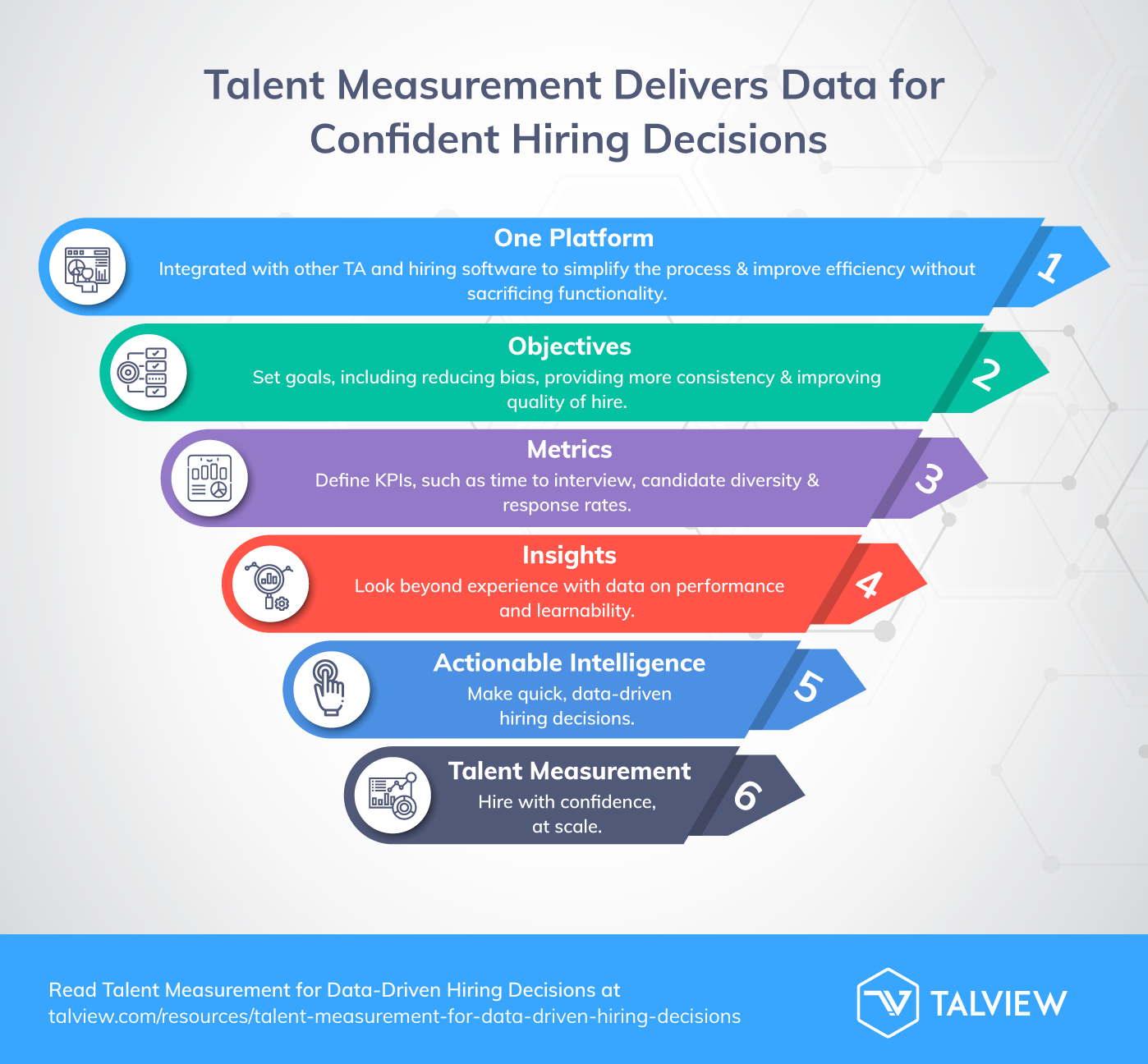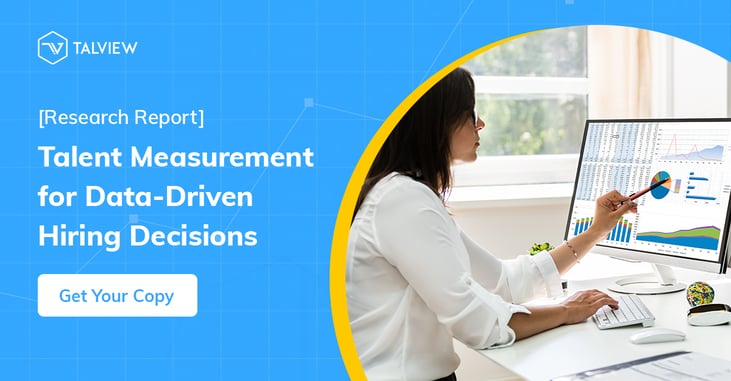A Talent Measurement Platform Delivers the Data Required for Confident Hiring Decisions
Approximately half of all companies are rethinking their hiring process. It’s no surprise, given that so many businesses are finding it impossible to hire top talent even though there are plenty of job seekers out there.
Not only can potential candidates be more selective about the roles they accept, but companies don’t have the tools they need to discover the best-fit applicants. This can lead to rushed or poor hiring decisions, which leads to more complications in the long run – everything from a new hire not being capable of performing the role needed to poor employee retention.
In December 2021, the average time it takes to hire someone hit an all-time high. Of course, the average time to fill a vacancy varies by industry, position, and location. Still, as a talent acquisition or hiring manager, you want to make a confident hiring decision in the shortest amount of time possible.
Many enterprises have turned to applicant tracking systems (ATS) to solve their dilemma, but even so, only one-quarter of businesses will reach their hiring goals this year. An ATS only offers a workflow. Confident hiring decisions require a deeper insight into the candidate.
The solution lies in a top-down system based on data-driven insights that provide a 360-degree view of a candidate. Revamping your hiring solution can offer reductions in time and cost per hire, an improved quality of hire, and better overall hiring decisions.

Let’s explore what you need at each level to reach your hiring goals and craft a seamless recruitment process.
One Platform
First and foremost, you need to consolidate your hiring technology. Your talent acquisition (TA) and hiring software need to be integrated into a centralized platform to streamline your process and improve efficiency without sacrificing functionality.
62% of companies use more than one assessment provider, which leads to different experiences and data management. Without consistent data, it’s impossible to make informed decisions about candidates.
If you’re looking to revamp your current system completely, then look for a tool with all the features you’ll need to execute your hiring process efficiently. If you don’t want to reinvent the wheel entirely or you’re attached to some of your current tools, then a solution that offers app or API integrations will do the trick. What matters is that you have all the information you need for hiring in one dedicated place.
Consolidating your hiring process into one system, one source of candidate truth, ensures that your company will be able to provide consistency throughout the screening, assessment, and interview processes.
Screening
With the help of artificial intelligence (AI), businesses can efficiently screen all candidates and provide data-driven decisions for every job role. Additionally, AI makes it easier for your company to engage with candidates to help you gather applications from top talent. AI also enables automated communication with candidates to let them know about the application process.
Assessment
Assessments have become a significant part of choosing candidates. If you don’t have a centralized option for administering pre-hire skills assessments, you risk missing out on the best candidate. An applicant is more than just their resume, and assessments can provide multi-faceted insights about skill, fit, and potential when executed correctly.
Interviewing
Interviewing is a staple in the hiring process, but so few companies have a standardized interview process. Instead of hosting a series of one-on-one ad hoc interviews that rely on a “gut feeling” to select a candidate, it’s more efficient to create a consistent interview process across the organization that includes skills assessments and makes the hiring process a team effort.
Objectives
Once your system is in place, it’s time to focus on your hiring goals. Ask yourself (or your team) what your objectives are and how they align with your company.
Defining your objectives gives you clarity so you can be incredibly specific about your hiring decisions. In some cases, you may have more than one hiring goal. That’s okay. Some common hiring goals include:
- Reducing bias
- Providing more consistency
- Improving the quality of hire
Some of these ideas can feel vague, so it’s crucial to ensure your hiring team is on the same page about what you mean. For instance, “diversity” can mean many different things, so it’s best to sit down with your team members and create a specific definition of what a diverse candidate will look like for your company.
Select a key performance indicator (KPI) for each objective that will enable you to track your growth moving forward. Ideally, your platform will track KPIs for you, so all you have to do is analyze the reports.
Metrics
You’ll set more specific goals for individual hiring metrics with your overall objectives and KPIs in mind. For example, if your overall goal is to reduce bias in your hiring process, the metrics you’ll want to observe may include:
- Percentage of diverse candidates who submitted an application
- Percentage of diverse candidates who completed an assessment
- Whether the assessment is offering differential predictions
- Percentage of diverse candidates interviewed
- Percentage of diverse hires
Other hiring metrics you may want to track include:
- Time to interview
- Quality of hire
- Candidate experience
- Time to fill
- Candidate response rates
- Number of applicants
- Offer acceptance rate
- Number of open positions
- Application completion rate
- Source of hire
- Sourcing channel effectiveness
It will be essential to define precisely what you mean in some cases. While measuring quantitative data such as time to hire or the number of applicants is easy, evaluating qualitative data like the quality of hire presents more of a challenge. Take the time to discuss how you will measure quality and go from there.
Insights
Insights allow businesses to use their data to make decisions and ask pertinent questions to inform their actions.
For instance, one of the more pressing hiring goals is reducing bias in the recruitment process. Companies need to look closely at their internal (and usually unconscious) biases and understand how it impacts their talent acquisition efforts. Companies should address the various factors that influence bias, such as wording in the job descriptions, assessment or screening questions, and the timing of interviews.
By using your data to understand your process, you’ll be able to take direct action to improve your hiring process.
Actionable Intelligence
There are numerous ways to turn your insights into action. For example, you can use your collected data to:
- Create or redesign your standard approach for interviewing, tracking, and collecting feedback. A standardized approach to your hiring process ensures that every applicant has the same experience at every stage. You may even consider expanding your insight collection to evaluate candidates beyond the application phase of talent acquisition.
- Collect unbiased assessment data to make more informed decisions. With the insights provided by intelligent assessments, you’ll have a clearer picture of what a candidate brings to the table. Assessments help you achieve a comprehensive understanding of a candidate that you can’t get from a resume alone. Companies that leverage assessment providers are three times more likely to improve the quality of hires.
- Employ AI to reduce bias by identifying it in real-time. Companies who use AI can significantly reduce unconscious biases in job descriptions and resume analysis, identify interviewing scoring patterns, use assessments to inform decision-making, and bring visibility to what needs to change.
By using your collected insights, located on a single platform, to take action, you’ll be able to make quick, data-driven hiring decisions with confidence.
A Talent Measurement Platform
The final step in the process is hiring for every position with confidence. With the other five elements taken care of, you can focus on talent measurement. Use the compiled data from each step of the hiring process to analyze individual candidates – from skill assessments to behavioral insights – to make an informed decision on the best-fit, best-qualified hire.
Talent measurement, a single source of truth, encompasses the strategies required to enable data-driven decisions.
Integrated Hiring Solutions for Talent Measurement
Your hiring solution should enable you to tailor your specific recruitment process to attract, recruit, assess, and hire the best possible candidates in your industry.
The Talview AI-Powered Hiring Solution seamlessly orchestrates data to provide the candidate insights you need to make quick, confident hiring decisions. Request a demo today to see how Talview can deliver the tools you need to boost the performance of your hiring teams.








Leave a Reply